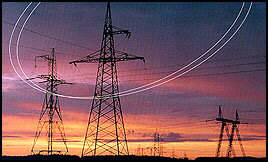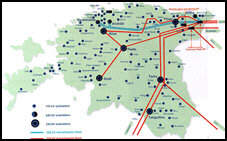 COMPANY PROFILE COMPANY PROFILE |

Eesti Energia AS is a vertically integrated, 100% state owned joint-stock company active in power production, transmission, distribution, sale and other energy related services with its main territory of business being the Republic of Estonia.
Eesti Energia AS was established on April 1st, 1998 on the basis of the former state enterprise and its subsidiaries. Although all the shares are held by the Government, the transformation from a state enterprise into a comercial undertaking brought the company closer to a more efficient business organisation characteristic of a free market economy and increased their competitiveness in the international market. During the years 1998-99, the government took several important decisions with regard to the privatization of Eesti Energia. It was resolved that 49% of the shares in Narva Elektrijaamad would be sold to a strategic investor and 51% would remain in the possession of Eesti Energia. It is the only power company in the world that gets its baseload from oil-shale fired power plants.
Eesti Energia is the biggest company in Estonia with its annual net sales in 1998 of 240 million euros as well as the biggest employer with over 12,000 people today.
 Structure of Eesti Energia Structure of Eesti Energia |

Click to enlarge
Eesti Energia's business activity is organised through separate business units,
· IRU POWER PLANT produces thermal energy and electricity. Installed electrical capacity is 190 MW and thermal 825 MW, fuels used are gas/oil.
· NARVA POWER PLANTS was formed by uniting Balti Power Plant and Eesti Power Plant into a single BU on April 1st, 1999 in order to optimize administration costs and increase production efficiency. Narva PP produces thermal 84 MW, in Balti PP the respective figures are 1390 MW and 690 MW, fuel used is oil shale.
· NATIONAL GRID is comprised of transmission network and substations of 110 kV-330 kV. Its main duty lies in connecting larger power plants and substations into a single power system in order to guarantee the necessary resources for electricity transmission.
· NATIONAL CONTROL CENTRE is currently a part of the grid , its main task being maintaining energy balancce and assuring efficient and smooth functioning of electricity system.
· DISTRIBUTION NETWORK was formed in April 1st 1999 on the basis of 5 regionall networks in order to promise administration costs and increase management efficiency. Distribution Network provides electricity distribution and sales services in medium and low voltage networks (below 110 kV).
· ENERGOREMONT is the biggest maintenance service provider for Eesti Energia power plant's machinery. In addition, Energoremont produces spare parts and does contractual work for companies outside power system.
· REAL ESTATE, a new business unit from
April 1st 1999, has its main responsabilities in
managing real estate belonging to Eesti Energia. |
 Our mission Our mission |
Eesti Energia is called to be a continously operating unified system of power production, transmission and distribution, with an obligation to provide customers in the Republic of Estonia with quality power meeting their needs.
 Main operation objectives Main operation objectives |
- Management and monitoring of joint parallel operation of the power plants, national grid and distribution networks included in Estonian power system.
- Securing optimum and reliable operation of Estonian power system.
- Development of power production technology and power networks
- Coordination of technical cooperation with power systems of other countries
- Continued enhancement of economic efficiency corresponding to the interests of shareholders.
 Facts about Eesti Energia AS Facts about Eesti Energia AS |
Net sales (1998) EUR 240 mill.
Cash flow from operating activities EUR 35 mill.
Total Sale of electrical energy5.8 Twh
Market share in Estonia
- Electricity production 95%
- Electricity sales 92%
Total Length of lines
National Grid (330-110 kV): 5,338 Km
Distribution network (<110 kV): 59,133 Km
Total capacity of transformers
National Grid (330-110 kV): 5,628 MVA
Distribution network (<110 kV): 4,899 MVA
Presently available net generation capacity
Eesti power plant 1197 MWe 84 MWth (oil-shale fired)
Baltic power plant 1189 MWe 505 MWth (oil-shale fired)
Iru Power Plant 149 MWe 459 MWth (gas and HFO fired)
International co-operation
As the biggest power company in Estonia, Eesti Energia
AS is participating in several international projects analysing power production, transmission and environmental issues in the Baltic Stattes and neighbouring areas
UNIPEDE is an international union of electricity producers and distributors. UNIPEDE's activities are directed mainly to Europe with the main task to work with strategic issues (EU among others) beyong politics. Eesti Energia AS became an active member in 1995 and affiliated member in 1997.
BALTREL is a high level advisory body for co-operation and consultation consisting of major power companies in the Baltic Sea Region. The aim of BALTREL will be to take further the discussions on the preconditions for increased trade, common rules and co-ordination of development plans in the Baltic Sea Region.
BALTIC REGIONAL ENERGY DEVELOPMENT PROGRAMME (BREDP). The aim is to carry out long-term planning of electricity supply for the region to secure the energy and generating capacity balance in production and consumption, with optimum costs.
DC BALTIJA is a dispatch centre of Baltic power companies (Eesti Energia, Latvenergo, Lietuvos Energija), co-ordinating as an Independent System Operator the technical co-operation between the Integrated Power system of the Baltics and the Unified Power System of Russia and Belarus.
TEN-ENERGY STUDY: East-West High Power Electricity Transmission System - Baltic Route - the aim of the study is to investigate the possibilities of joining the East European non-synchronous energy systems synchronously with the West-European UCPTE system and to enable profitable energy and capacity exchanges. |

